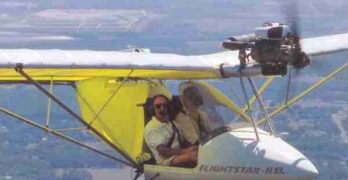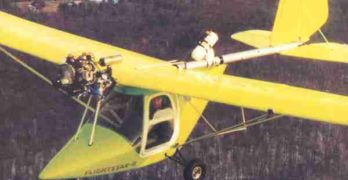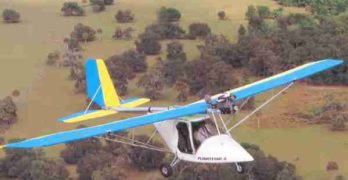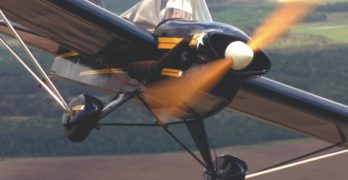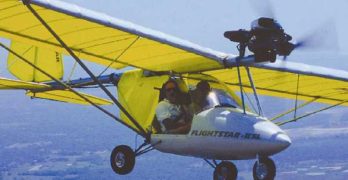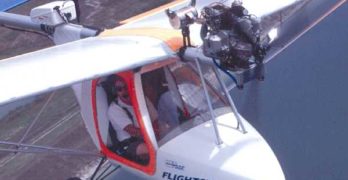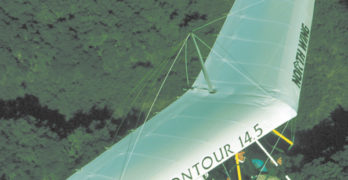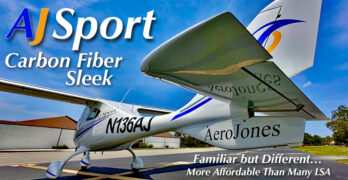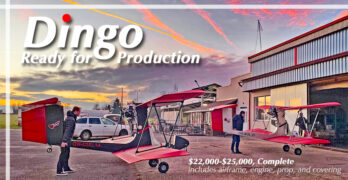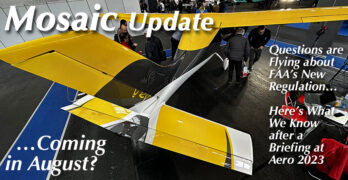“New & Improved” boasts the advertising for the Flightstar IISL as it was introduced at the start of the 1999 season. Indeed, the statement proved to be more than a catchy advertising slogan. The already-popular ultralight from the Connecticut company managed to go one better than earlier models.
A series of changes subtly advanced the state of the art for one of America’s best ultralights. A new cabin fairing was cunningly reshaped to combine smoothly with a new, curvier windscreen. The aft-cabin fabric fairing was made leaner and smaller yet more efficient. And a new engine cowling improved cooling for the Rotax 503 engine installation.
The combination of front and rear fairing harmonized to bring smoother touchdowns eliminating the one nagging challenge I’d found in the older IISL. Making consistently smooth landing roundouts is now child’s play. Builders will also appreciate the easier fit of the new fiberglass parts and shipping is more compact (therefore cheaper) than ever due to the change.
Search Results for : Flight Design
Not finding exactly what you expected? Try our advanced search option.
Select a manufacturer to go straight to all our content about that manufacturer.
Select an aircraft model to go straight to all our content about that model.
Flightstar Inc. — Flightstar II + HKS Engine
Daring to take on deeply entrenched Rotax, Flightstar/H-Power has introduced the first light aviation four-stroke engine to see broad acceptance. Joined with their smoothly contoured Flightstar II, you can have a deluxe ultralight or lightplane that will provide years of flying enjoyment.
While two strokes do the job for most ultralight enthusiasts, the four stroke 700E engine from HKS of Japan offer assurances some pilots demand. With its particular strength of mid-range torque, the HKS engine brings interesting differences. Pull up the nose while revolutions are set in the 4000s and the HKS will haul the Flightstar II aloft with no evidence of prop loading common among two stroke engines.
Flightstar still sells lots of their very popular IISL models, but on this lighter aircraft, they recommend the Rotax 503. However, now that the same company has adapted the stronger HKS engine, sales are soaring for their Flightstar II with its beautifully formed all-fiberglass cockpit enclosure.
Flightstar II
The popular Flightstar is solidly an American aircraft again after an excursion with overseas ownership. Original designer, Tom Peghiny, and his partner, Sparky LaMontagne, are majority owners in the Connecticut-based ultralight manufacturer. They’ve introduced four models to the community: Flightstar Classic (277 engine), Spyder (447-powered single place), Formula (deluxe full enclosure single seater) and Flightstar (top of the line two-place aircraft).
The Flightstar line distinguishes itself by featuring well engineered designs with cleanly executed hardware on a sleek, solid design. As they pass by in an airshow demonstration, viewers are pleased by the quiet performance of the machines. Factory pilots fly their two place model with the lighter 503 engine; it’s more than enough engine though you can add the more powerful 582. They go fast as well as slow and handle well at either end of the envelope. Present models offer flaps to further extend the speed range.
Efficiency is a watchword with the Flightstars.
Proven Design; Ison Aircraft’s Eros
The pretty blue Eros with bright yellow stars on it is no ordinary ultralight. On second thought, “ordinary” and “Eros” aren’t words that go together. Of those aircraft designed by Wayne Ison and his former TEAM team, this model is the hottest of the fleet. I believe I’ve flown all Ison designs that were put into manufacture and Eros is one of my favorites. (In truth, it’s a tossup between the Max-103, Air-Bike, and the Eros.)
The Legend of Davy Lee
For this month’s pilot report, I got the chance to fly a special Eros, a Grand Champion at Sun ‘n Fun ’98 in the Lightplane Class. It belongs to owner/builder/pilot Davy Lee Cooper and it represents my second review of an Eros.
Cooper’s Eros is Rotax 503-powered as was the earlier Eros I flew, but both are derived from the Eros-preceding V-MAX with a Half VW engine. Without a doubt the Rotax 503 is more energetic, yielding better climb rates and somewhat faster speeds.
Flightstar II SL
Since Tom Peghiny and partner Spark Lamontagne first lightened the Flightstar and named one model the II SL (for “Sport Light”), they haven’t been able to sit still and simply admire their work. From our first pilot’s report on the SL 3 years ago,1 the two have tweaked and adjusted the model to find even better qualities.
A new front and aft fairing are part of the package, and the latter you might notice rather quickly. Virtually all the rest of the improvements are subtle things. In fact, that word is a hallmark of Flightstar innovation.
No surprise then that the company should adopt “New and Improved” as its new advertising headline to assure you know about the changes.
Better and Better
I’ve followed the Flightstar from its first flight, when it wasn’t even the Flightstar. This design – which once crossed the Atlantic – is from the inventive mind of Swiss national Hans Gygax, and became the rather gaudy 440ST.
Flightstar II Sport Cabin
In August 1999,Ultralight Flying! reported on the Flightstar II SL. Thirteen months later, another report is needed as, once again, Tom Peghiny and Spark Lamontagne have upgraded their principal selling model.
Flightstar is the name of the plane and Flightstar Sportplanes is the name of the company, and “refinement” ought to be permanently attached. I’ve followed many ultralights over many years. Some have changed a lot, some have seen almost no change. The Flightstar has almost constantly evolved.
Why change this successful design? After all, it costs money to design, test and build new parts inventories. It takes time and more money to update assembly manuals. Why do all this if the ultralight is doing well? The reason is simple: to make a better product that more people will buy. At least the answer sounds simple; in fact, it may be surprisingly complicated to achieve.
Before we get into how the ultralight flies, let’s review what makes this Flightstar II SC (Sport Cabin) different from the Flightstar II SL (Sport Light).
North Wing Design’s Loaded Apache
North Wing Design has a history that stretches back into the mid-1980s when 23-year-old owner Kamron Blevins started making hang glider wings. After gaining experience with other companies and dabbling with his own ideas along the way, Blevins started North Wing Design in 1996 to provide trike wings.
His timing was good. After years of work to encourage Americans to consider trikes, various suppliers – many from Europe – were pleased to see their efforts pay off. Trike numbers began to increase about the time North Wing Design got into business. At first, Blevin’s new company created specially built trike wings for several chassis suppliers and the enterprise grew.
With increasing sales of wings to others and with a rising tide of trike interest lifting all manufacturers, North Wing Design decided to go all the way. Their first full trike ultralight offering in 1999 was the Maverick, a slick single-seater that met FAR Part 103 parameters with a Rotax 447 (see “Pilot’s Report: North Wing Design’s Maverick Trike,” September 1999 Ultralight Flying!
New “Made-in-USA” Aircraft — Welcome AJ Sport to the LSA Fleet
Is it because of tariffs? Another reason? Or simply a good idea? Does it matter why you’re reading about AJ Sport?
U.S. government policies swing and sway the world in remarkable ways. That’s a whole story in itself, but the way aircraft suppliers respond to the situation they are facing can be instructive.
To be clear, AeroJones Aviation is not reacting to tariff changes. This company, headquartered in U.S.-friendly Taiwan, has been working toward entering the American market for years. For more than a decade, AeroJones has been the officially-licensed producer of Flight Design’s CTLS and CTLSi for Asia-Pacific. They don’t simply import and sell units built in Europe. They do 100% of the fabrication, assembly, and production test flights in the Asian theater. They’ve delivered more than 50 aircraft and have won multiple CAAC airworthiness approvals.
A video to follow soon features SilverLight Aviation‘s Abid Farooqui describing several notable changes the company achieved.
Super-Affordable Part 103 Dingo (low $20,000s, complete) Enters Production
While you continue digesting FAA’s 318-page thriller on Mosaic, here’s a fun aircraft that does not have to spend even one minute meeting those new rules. I’ve written about the Part 103-compliant Dingo from Future Flight before (this article) but the delightful biplane is now entering production.
Tom Peghiny of Flight Design USA fame, wrote, “Jan Jilek is one of the design engineers of Future Vehicles as well as their test pilot. He is also a talented aerobatic performer. We flew together in a few planes while I was working in Sumperk, CZ [as a consultant to Flight Design].”
Dingo was created by Marek Ivanov. At the beginning of 2021, he showed the first 3D images to the Future Vehicles team. This is an experienced group that does a wide range of engineering work for a variety of aircraft producers.
Describing Dingo
Dingo’s airframe is primarily riveted 6061 and 2024 aluminum sheet.
After Spring Airshows, Mosaic Questions Emerge — Here’s What We Know Before FAA’s NPRM Is Released
LAMA, the Light Aircraft Manufacturers Association, hosted a gathering of European manufacturers during last month’s Aero Friedrichshafen show. Van’s Aircraft President and Chief Engineer Rian Johnson accepted LAMA’s invitation and presented an update on Mosaic. As the leader of the ASTM committee working on LSA standards, he covered expected changes to help manufacturers prepare.
How can builders design for a regulation they haven’t seen? Thanks to the use of industry consensus standards, the lighter aircraft industry is more aware than you might expect.
Understandably, manufacturer interest is keen; it’s their business. At the same time, individual pilots increasingly raise similar questions.
Top-Four Questions
I’ll address some common inquiries before getting into specifics of the LAMA meeting. The following reflects questions I’ve often heard, along with my responses. As you read these, remember, I am merely one reporter describing discussions I’ve heard. Disclaimer: Information in this article is not official and may not reflect what FAA is planning.
- « Previous Page
- 1
- …
- 10
- 11
- 12
- 13
- 14
- …
- 147
- Next Page »


